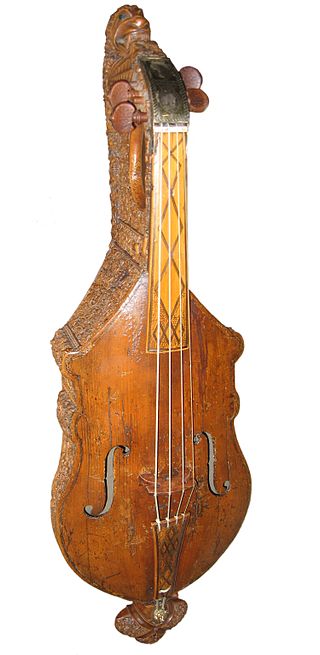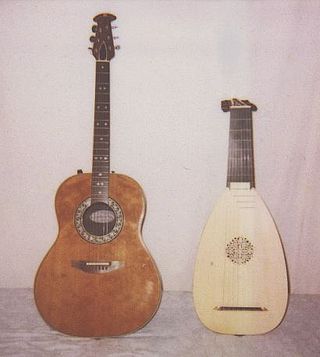Related Research Articles

A harpsichord is a musical instrument played by means of a keyboard. This activates a row of levers that turn a trigger mechanism that plucks one or more strings with a small plectrum made from quill or plastic. The strings are under tension on a soundboard, which is mounted in a wooden case; the soundboard amplifies the vibrations from the strings so that the listeners can hear it. Like a pipe organ, a harpsichord may have more than one keyboard manual, and even a pedal board. Harpsichords may also have stop buttons which add or remove additional octaves. Some harpsichords may have a buff stop, which brings a strip of buff leather or other material in contact with the strings, muting their sound to simulate the sound of a plucked lute.

In musical instrument classification, string instruments, or chordophones, are musical instruments that produce sound from vibrating strings when a performer plays or sounds the strings in some manner.

The lyre is a stringed musical instrument that is classified by Hornbostel–Sachs as a member of the lute family of instruments. In organology, a lyre is considered a yoke lute, since it is a lute in which the strings are attached to a yoke that lies in the same plane as the sound table, and consists of two arms and a crossbar.

In organology, the study of musical instruments, many methods of classifying instruments exist. Most methods are specific to a particular cultural group and were developed to serve that culture's musical needs. Culture-based classification methods sometimes break down when applied outside that culture. For example, a classification based on instrument use may fail when applied to another culture that uses the same instrument differently.

A plectrum is a small flat tool used for plucking or strumming of a stringed instrument. For hand-held instruments such as guitars and mandolins, the plectrum is often called a pick and is held as a separate tool in the player's hand. In harpsichords, the plectra are attached to the jack mechanism.

Zithers are a class of stringed instruments. In modern terminology, it is more specifically an instrument consisting of many strings stretched across a thin, flat body, the topic of this article.

A psaltery is a fretboard-less box zither and is considered the archetype of the zither and dulcimer. Plucked keyboard instruments such as the harpsichord were also inspired by it. Its resonance box is usually trapezoidal, rectangular or in the form of a "pig's head" and often richly decorated.

The citole was a string musical instrument, closely associated with the medieval fiddles and commonly used from 1200–1350. It was known by other names in various languages: cedra, cetera, cetola, cetula, cistola, citola, citula, citera, chytara, cistole, cithar, cuitole, cythera, cythol, cytiole, cytolys, gytolle, sitole, sytholle, sytole, and zitol. Like the modern guitar, it was manipulated at the neck to get different notes, and picked or strummed with a plectrum. Although it was largely out of use by the late 14th century, the Italians "re-introduced it in modified form" in the 16th century as the cetra, and it may have influenced the development of the guitar as well. It was also a pioneering instrument in England, introducing the populace to necked, plucked instruments, giving people the concepts needed to quickly switch to the newly arriving lutes and gitterns. Two possible descendant instruments are the Portuguese guitar and the Corsican Cetera, both types of cittern.

The epigonion was an ancient stringed instrument, possibly a Greek harp mentioned in Athenaeus, probably a psaltery.

Plucked string instruments are a subcategory of string instruments that are played by plucking the strings. Plucking is a way of pulling and releasing the string in such a way as to give it an impulse that causes the string to vibrate. Plucking can be done with either a finger or a plectrum.

The nevel, nebel, was a stringed instrument used by the Phoenicians and the Israelites. The Greeks translated the name as nabla.

Angular harp is a category of musical instruments in the Hornbostel-Sachs system of musical instrument classification. It describes a harp in which "the neck makes a sharp angle with the resonator," the two arms forming an "open" harp. The harp stands in contrast to the arched harp or bow harp in which the angle is much less sharp and in which the neck curves away from the resonator. It also stands in contrast to the frame harp which is a "closed harp" and in which there is no opening between the resonator and the upper tip of the harp, but has a third side forming a triangle.

The kithara, Latinized as cithara, was an ancient Greek musical instrument in the yoke lutes family. It was a seven-stringed professional version of the lyre, which was regarded as a rustic, or folk instrument, appropriate for teaching music to beginners. As opposed to the simpler lyre, the cithara was primarily used by professional musicians, called kitharodes. In modern Greek, the word kithara has come to mean "guitar", a word which etymologically stems from kithara.

The sambuca was an ancient stringed instrument of Asiatic origin. The term sambuca is also applied to a number of other instruments.

The Swarabat, Swarbat or Swaragat is a rare plucked string instrument of the classical Carnatic music genre of South India. It belongs to the chordophone, lute family of musical instruments, and is closely related to the veena and yazh instruments of the ancient South Asian orchestral ensemble.

The veena, also spelled vina, is any of various chordophone instruments from the Indian subcontinent. Ancient musical instruments evolved into many variations, such as lutes, zithers and arched harps. The many regional designs have different names such as the Rudra veena, the Saraswati veena, the Vichitra veena and others.

Mechanical music technology is the use of any device, mechanism, machine or tool by a musician or composer to make or perform music; to compose, notate, play back or record songs or pieces; or to analyze or edit music. The earliest known applications of technology to music was prehistoric peoples' use of a tool to hand-drill holes in bones to make simple flutes. Ancient Egyptians developed stringed instruments, such as harps, lyres and lutes, which required making thin strings and some type of peg system for adjusting the pitch of the strings. Ancient Egyptians also used wind instruments such as double clarinets and percussion instruments such as cymbals. In Ancient Greece, instruments included the double-reed aulos and the lyre. Numerous instruments are referred to in the Bible, including the horn, pipe, lyre, harp, and bagpipe. During Biblical times, the cornet, flute, horn, organ, pipe, and trumpet were also used. During the Middle Ages, hand-written music notation was developed to write down the notes of religious Plainchant melodies; this notation enabled the Catholic church to disseminate the same chant melodies across its entire empire.

Hittite music is the music of the Hittites of the 17th–12th century BC and of the Syro-Hittite successor states of the 12th–7th century BC.

The Anglo-Saxon lyre, also known as the Germanic lyre, a rotta, or the Viking lyre, is a large plucked and strummed lyre that was played in Anglo-Saxon England, and more widely, in Germanic regions of northwestern Europe. The oldest lyre found in England dates before 450 AD and the most recent dates to the 10th century. The Anglo-Saxon lyre is depicted in several illustrations and mentioned in Anglo-Saxon literature and poetry. Despite this, knowledge of the instrument was largely forgotten until the 19th century when two lyres were found in cemetery excavations in southwest Germany. The archaeological excavation at Sutton Hoo in 1939, and the correct reconstruction of the lyre in 1970, brought about the realisation that the lyre was "the typical early Germanic stringed instrument."

The psalterion is a stringed, plucked instrument, an ancient Greek harp. Psalterion was a general word for harps in the latter part of the 4th century B.C. It meant "plucking instrument".
References
- 1 2 3 Athenaeus, Deipnosophists, 14.36
- 1 2 Barker, Andrew (1984). Greek Musical Writings: Volume 1, The Musician and His Art. Cambridge University Press. p. 294. ISBN 0521389119 . Retrieved 11 August 2019.
- 1 2 Maas, Martha (1989). Stringed Instruments of Ancient Greece. Yale University Press. p. 149. ISBN 0300036868 . Retrieved 11 August 2019.
- ↑ Posidonius: Volume 3, The Translation of the Fragments. Cambridge University Press. 1972. ISBN 0521622581 . Retrieved 11 August 2019.
- ↑ ψάλλω δ´ εῐχοσι / γοοδαῑσι μάγαδιν εχων / Ω Αεύχασπι, σύ ο ήβᾶις
- ↑ ᾰλλος δ' ᾰλλαν χλαγγὰν ίεὶς / χεοατόφωνον ὲοέυιζε μάγαδιν / [ὲν] πενταοοάβδω χοοδᾱν ὰονμῶ / χέοα χαμψιδίανλον ὰναστοωψῶν τάχος